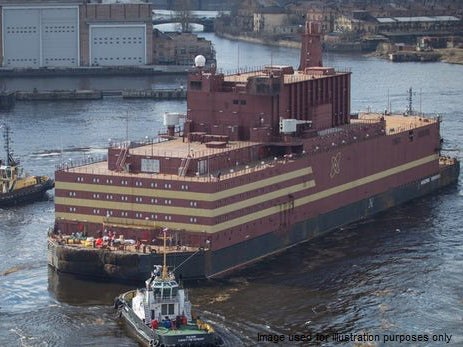World's only floating nuclear power station dubbed 'Chernobyl on ice' launched by Russia
Akademik Lomonosov poses ‘shockingly obvious threat’ to environment, campaigners claim

A floating nuclear power plant that environmental campaigners have dubbed “Chernobyl on ice” is ready to begin supplying electricity, Russia has announced.
The Akademik Lomonosov is reportedly destined to provide power for a region in Russia’s far east, although its design means it could be towed wherever there is a need for extra electricity.
Russia’s UK embassy tweeted that the 144m vessel, “the world’s only floating nuclear power unit, is ready to begin commercial operations following a series of successful tests on its twin KLT-40 reactor system”.
While the ship is currently thought to be the only one of its kind, China is constructing a similar floating power station. It plans to place nearly two dozen in the South China Sea where Beijing is expanding its military presence.
Chinese state broadcaster CCTV hinted at the possibilities for the devices create when it reported in March that they “can dynamically adjust [their] mooring position according to needs, for remote areas, important islands and offshore oil and gas exploration platforms [to] provide clean electricity, heat and fresh water”.
After the Akademik Lomonosov was launched, Russia’s TASS news agency reported that it would begin supplying electricity to the far eastern Chukotka province by the end of the year after it moors in the Arctic port of Pevek.
The agency said the ship’s 70-megawatt reactors could power a city of 200,000 people.
Last year, as Russia prepared to test the ship, Greenpeace claimed that “nuclear reactors bobbing around the Arctic Ocean will pose a shockingly obvious threat to a fragile environment which is already under enormous pressure from climate change”.

The twin plants aboard Akademik Lomonosov are nautical models already believed to be in use on Russian icebreakers.
Rosatom, the state corporation which operates the vessel, says claims by Greenpeace of the ship's dangers "have never been supported by peer-reviewed and credible evidence."
It argues that the power unit will "contribute to the sustainable development of the Arctic region and to the fight against climate change by offering zero-carbon electricity generation and replacing heavy polluting fossil-fuel power sources."
Rosatom has also said the plant "does not pose any threat to the environment".
Nuclear reactors have been used to power warships since the mid-20th century, notably the US’ fleet of super-sized aircraft carriers and submarines from several nations.
Join our commenting forum
Join thought-provoking conversations, follow other Independent readers and see their replies
Comments